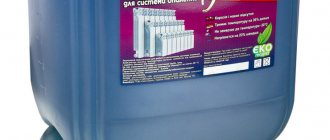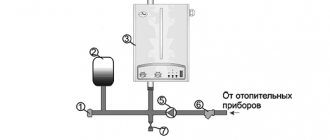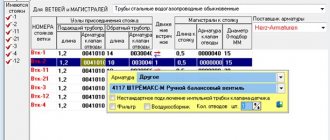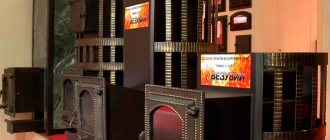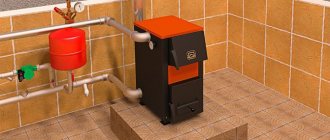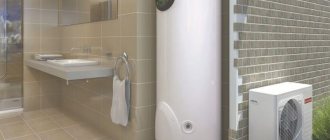Residents of multi-apartment buildings rarely encounter heating problems, since they are connected to a central system and do not think about whether to heat the house with wood, gas or electricity. But in private homes it is necessary to install boiler rooms, the financial costs of using and installing which can be reduced through the use of electric heating boilers. Thanks to it, the efficiency improves. Also, the water supply becomes uninterrupted, while its volumes increase.
What is the device
A boiler for heating a private house is a sealed structure, inside of which, unlike an indirect heating boiler, there is a special heating element. The operation scheme is simple - two couplers are used to connect to the water supply system. To heat the entire home, this device must be high-power. For every ten square meters you need one kilowatt. The larger the area, the more power is required. For example, a boiler heating with a device is suitable for a garage
A storage tank can be a good alternative to a classic device. The only difference is the internal pipeline connected to the heating system. Properly organized heating through a water heater involves this device performing the function of a thermal battery. The water inside receives energy through a coil located inside, which is connected to the heating system. When the boiler is turned off, the process will begin to occur in the reverse order: the temperature will begin to rise from the water in the boiler.
Warm floor system
A warm floor cannot be considered the main heating system, but it will work well as an additional source of heat. A warm floor is a structure consisting of a heating film and heating cables. This design is installed under the floor covering. Special temperature sensors are installed on some areas of the floor, which are connected to a thermostat installed on one of the walls of the room.
Warm cable floor
Electric heating such as underfloor heating allows you to independently regulate the heating in the apartment, setting a certain temperature regime. Installing such a heating system is not a very complicated process, so you can do it yourself, without turning to specialists for help. Here you can find many recommendations, as well as videos that will help you cope with this task. A system such as electric underfloor heating is not suitable as a universal heat source, so it will only be justified as an additional heating system.
Operating principle of a water heater for heating
The water heating boiler, which is used for heating, is made according to the principle of a regular thermos. The only difference is that heating is done by electricity or fire. There is a special tube in the tank through which cold water flows. As soon as it reaches the required temperature, the heating is immediately turned off. The heating element has the shape of a spiral. Hot water flows through it. The presence of a magnesium anode is also required, which is intended to serve as protection against corrosion. The thermostat and safety valve are located nearby.
The pipeline heats the liquid. Due to the coolant, the required temperature regime is achieved in it. Pumps circulate the coolant. It is worth remembering that their installation is carried out simultaneously with the installation of the boiler.
Peculiarities
There is no need for very complex calculations or the use of precise instruments and measurements. Every self-respecting paint manufacturer, for example, Dulux, presents on its website a special calculator that allows you to calculate the actual consumption of paint and varnish material almost accurately. In addition, the consumption rate of paint and varnish material must be written on cans and other containers (how much surface can be painted with 1 kg or 1 liter of paint)
It is important to note that the marking shows the consumption of dye applied to a hard and perfectly smooth surface, which was treated with two layers of paint after thorough priming
Pros and cons of boiler-based heating
Heating obtained from a water heating tank has its advantages and disadvantages.
| pros | Minuses |
| No special tools, skills or engineering education required for installation | The installation process, in terms of labor resources, is quite expensive |
| Boilers are much cheaper than heating boilers | The unit is constantly in operating mode |
| Thanks to the thermal insulation layer, water heaters spend less derived heat than space heaters | The water supply must be constant, which can cause corrosion to occur prematurely. |
| It is possible to use wall or ceiling mounting type, so they take up little space | There is no required power to heat a large area |
| The amount of resources consumed is scanty, electrical energy consumption is minimal | |
| Allows you to independently regulate the temperature |
Types and principle of operation of drives
There are two types of electric boilers:
- Built-in - included in the water supply system existing in the house;
- Bulk - autonomous containers not connected to the water supply system. The user fills in the required amount of water independently.
95% of modern storage water heaters belong to the first group. They allow you to fully automate the process of heating water and maintaining its volume in the tank without user intervention.
It is worth paying attention to bulk storage water heaters if the premises do not have a water supply system at all.
The place of installation of autonomous models can be baths, outbuildings, private houses, the water supply of which is carried out from water wells or wells
The built-in water heater is located close to the existing water supply system and is connected to it with hoses (pipes). Depending on the shape and capacity, they can have a floor or wall design, located vertically or horizontally, depending on the characteristics of the room.
The shape of storage water heaters can be cylindrical or rectangular, which allows them to fit rationally into the interior without losing the volume of the room
Some models provide for hidden installation in niches in the bathroom or under the sink.
After installation and connection of water and electrical communications, the water heater begins to operate in automatic mode. It is enough to open the hot water supply tap so that heated water for domestic use begins to flow immediately. The volume of its supply depends solely on the capacity of the water heater.
After the container is completely empty, the storage tank switches to the water collection and heating mode. Thus, its operation is cyclical, and breaks in readiness for the next use depend on the capacity of the tank and the power of the water heating elements.
Instantaneous water heater
A flow-through water heating boiler does not have a container designed for a large volume. It is designed so that the water consumed is heated instantly. There are two types used in everyday life:
- Electric - production takes place in a compact case, wall mounting. Water is heated as it passes through an electric heater.
- Gas - water flows inside the heat exchanger. A gas burner burns under it, which heats the liquid.
An instantaneous electric water heater intended for heating has the following device:
- Body - the material is metal or plastic, the outside is covered with a special coating for protection and decoration.
- Heat transfer tube - located inside the housing, most often has a spiral shape.
- The heating part is located in the heat exchange tube or in a separate metal glass.
- Flow meter - there is a reaction to the closing/opening of the faucet mixer.
- Electromagnetic starter - controls a magnetic starter and is a powerful electric heater.
- Thermostat - turns the unit on/off, regulates the supply of hot water based on the pressure power.
- Thermal fuse - necessary for emergency shutdown of the device.
| pros | Minuses |
| Light weight, compact parameters | Due to their complex manufacturing, their price is quite high. |
| It is possible to operate immediately as soon as it is turned on, since the water heats up quickly | High electricity consumption |
| Connection and installation can be done independently in an hour and a half | To connect, it becomes necessary to lay another network cable separately |
| All parts inside are made of metal that is not subject to corrosion |
Do you know that..
If you want to install a classic boiler as the main heating part, problems such as malfunction of the unit may arise.
Electric storage boiler
Electric storage boilers are most often used in everyday life. Externally they have differences, but the device itself is the same:
- The case is made of steel with a thickness of 0.8 millimeters. A polyester enamel coating is applied on top, serving not only as decoration, but also as protection.
- The tank is located inside the body, made of steel 1.2 millimeters thick, the outside is coated with corrosion protection. It has three types. The first is a heat-strengthened coating, used in inexpensive models. It is considered not particularly durable: the enamel can crack and crumble due to a sharp change in temperature. The second is glass ceramics, applied at high temperatures, very durable. The third is titanium coating, the most durable and strong, used on expensive models.
- Thermal insulation - minimum thickness is 20 millimeters, maximum - 40. It looks like a layer between the tank and the outer casing.
- Magnesium anode - designed to protect against rust. Installation takes place near the heating element and protects the tank and heating part from electromechanical corrosion.
- Heating element - located at the bottom of the tank.
- Thermometer - digital or mechanical. Located outside the housing, designed to control water.
- Thermostat - automatically turns on/off the heating element. Adjustment is manual or electronic.
- Indicator LED - connected to the thermostat, lets you know when the heating element is on or off.
- Water pipes are made of metal, end with a thread on the outside, and are connected to the water supply.
- Mounting Bracket - Used to mount the unit to the wall.
| pros | Minuses |
| A large assortment | Installation should only be carried out on a solid wall due to the heavy weight of the devices |
| Installation is simple, easy, completed in a couple of hours | Maximum service life is nine years, as corrosion resistance is reduced |
| Part replacement takes a maximum of one and a half hours | Due to the insulation, the parameters are quite dimensional |
| Low electricity consumption | Takes a long time to heat up (from half an hour to nine hours) |
| A thick layer of scale appears |
Types of devices
All boilers are divided into 2 main types:
- Flow type. In such a device there is only a small container, and the water is heated “on pass”. This is ensured by equipping boilers with high-power heaters. This type can be used to heat small rooms, but it will require high power consumption and continuous operation of the heater.
- Cumulative type. It is most suitable for heating systems, because... contains a tank in which water is heated. This boiler has a certain inertia, i.e. Heating of the room will begin only when the entire volume of the tank is heated, which will take a certain time. Subsequently, by creating a coolant reserve, you can periodically turn off the electricity supply, which reduces its consumption.
When we talk about boilers, we usually mean electrical devices containing heating elements. However, there is another option when water heating is provided by gas - gas boilers. They are used less frequently, but are quite suitable if there is a centralized gas supply. In this case, you can use the flow-through design of the device.
Keep in mind that the use of gas boilers for home heating requires obtaining special permission from the relevant services and installing a gas flow meter. No permit is required when using electrical household appliances.
Review of water heaters for home heating
Not all models of water heaters are suitable for heating a private home. Let's consider those that received positive ratings from user reviews.
Electrolux EWH 50 Quantum Pro
- Price - from 18,092 rubles.
- Dimensions (WxHxD) - 38.5x70.3x38.5 cm.
- Volume - 50 l.
- Weight - 18 kg.
- Power - 1.5 kW.
- Country of origin : China.
- White color
Electrolux EWH 50 Quantum Pro boiler
| pros | Minuses |
| Thermometer | |
| Temperature limitation | |
| Anti-scale protection |
Edison ER 50V
- Price - from 2350 rub.
- Dimensions (WxHxD) - 45x56x45 cm.
- Volume - 50 l.
- Weight - 18 kg.
- Power - 1.5 kW.
- Country of origin : England.
- White color
Edison ER 50V boiler
| pros | Minuses |
| overheat protection | |
| Glass ceramic inside | |
| Magnesium protective anode |
Hyundai H-SWS1-140V-UI706
- Price - from 18,757 rubles.
- Dimensions (WxHxD) - 34x63x34 cm.
- Volume - 40 l.
- Weight - 10 kg.
- Power - 1.5 kW.
- Country of origin : North Korea.
- White color
Hyundai H-SWS1-140V-UI706 boiler
| pros | Minuses |
| Protection against switching on without water | Mechanical control |
| overheat protection | |
| Magnesium protective anode |
Hyundai H-GW2-ARW-UI308
- Price - from 17,637 rubles.
- Dimensions (WxHxD) - 33x56x17.5 cm.
- Weight - 7.8 kg.
- Country of origin : North Korea.
- White color
Hyundai H-GW2-ARW-UI308 boiler
| pros | Minuses |
| Heating temperature limitation | Mechanical control |
| Display | |
| Thermometer |
Electrolux Smartfix 2.0 3.5 TS
- Price - from 6335 rub.
- Dimensions (WxHxD) - 27x13.5x10 cm.
- Weight - 1.5 kg.
- Power - 3.5 kW.
- Country of origin : China.
- White color
Electrolux Smartfix 2.0 3.5 TS boiler
| pros | Minuses |
| Fourth degree of protection against water | Mechanical control |
| overheat protection |
Thermex Hit 15 U (Pro)
- Price - from 14911 rub.
- Dimensions (WxHxD) - 38x41x34 cm.
- Volume - 15 l.
- Weight - 9.5 kg.
- Power - 3.5 kW.
- Country of origin : Italy.
- White color
Thermex Hit 15 U (Pro) boiler
| pros | Minuses |
| Magnesium anodic protection | Mechanical control |
| overheat protection |
Hyundai H-SWS15-50V-UI695
- Price - from 24843 rubles.
- Dimensions (WxHxD) -43.4x83.5x23 cm.
- Volume - 50 l.
- Weight - 12.6 kg.
- Power - 2 kW.
- Country of origin : North Korea.
- White color
Hyundai H-SWS15-50V-UI695 boiler
| pros | Minuses |
| Indication of inclusion and heating | Mechanical control |
| Check and safety valves |
Thermex Champion Silverheat ERS 80 V
- Price - from 19,698 rubles.
- Dimensions (WxHxD) - 44.5x75.1x45.9 cm.
- Volume - 80 l.
- Weight - 21.2 kg.
- Power - 1.5 kW.
- Country of origin : Italy.
- White color
Thermex Champion Silverheat ERS 80 V boiler
| pros | Minuses |
| overheat protection | Mechanical control |
| Magnesium anodic protection | |
| Safety valve | |
| Thermometer |
Hyundai H-SLS1-40V-UI706
- Price - from 29,673 rubles.
- Dimensions (WxHxD) - 28x97.6x28 cm.
- Volume - 40 l.
- Weight - 11.6 kg.
- Power - 1.5 kW.
- Country of origin : North Korea.
- White color
Hyundai H-SLS1-40V-UI706 boiler
| pros | Minuses |
| overheat protection | Mechanical control |
| Magnesium anodic protection | |
| Check valve | |
| Heating indication |
Hyundai H-SLS1-50V-UI707
- Price - from 24931 rub.
- Dimensions (WxHxD) - 28x117.6x28 cm.
- Volume - 50 l.
- Weight - 12.6 kg.
- Power - 1.5 kW.
- Country of origin : North Korea.
- White color
Hyundai H-SLS1-50V-UI707 boiler
| pros | Minuses |
| Magnesium anodic protection | Mechanical control |
| Stainless steel inside |
Did you know that...
From English the word “boiler” is translated as “boiler”. This means that, in addition to storage, it also includes instantaneous water heaters. In relation to consumers, not taking them into account will be considered incorrect.
Calculation of the volume of the storage tank and the power of the heating element
The main element of the boiler, which serves to heat water from the heating system, is volume. It can be calculated using the following formula: V=T*N/(t1-t2), where:
- V—volume;
- T is the time spent heating water;
- N is power measured in kilowatts per hour;
- t1, t2 — thermal regime of the mechanism.
The heating element is a tubular electric heater and the main component of the mechanism. It looks like a spiral wrapped in metal. The system must be filled with dielectric. For example, sand can be used as it. This indicator is subtracted using the following formula: P=0.0011*m*(tk-tн)/T, where
- P—power;
- m is the mass of water to be heated;
- tk is the initial temperature;
- tn — final temperature;
- T is the time spent heating the liquid.

